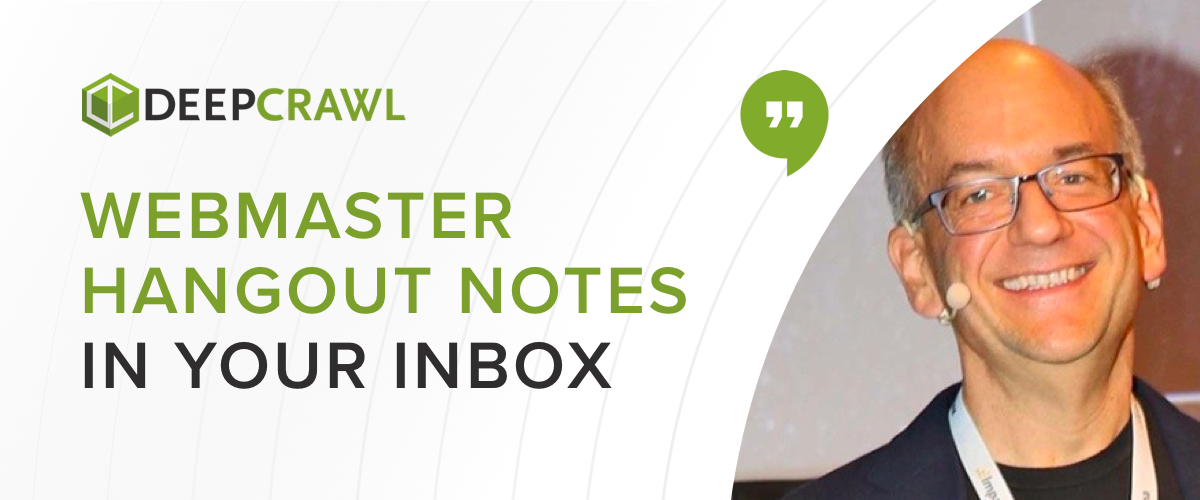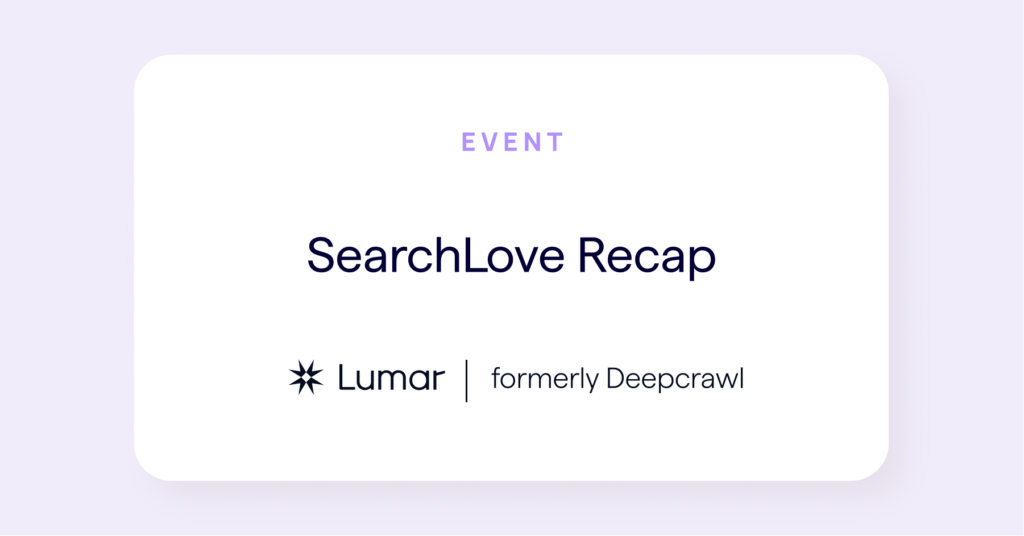Day 2 of SearchLove London 2018 saw many entertaining and informative talks. Let’s not beat around the bush and get straight into it. Here are the key takeaways from five of the day’s talks.
If you haven’t already read the first part of the SearchLove London recap you can find that here.
Ryan Charles – Newsjacking: How To Add to the Story and Earn Big Links in Real Time
Talk Summary
Ryan taught us how to facilitate big, viral moments, how to best manage them when you get one, and how to add to the story without being a “Newsjackass”.
Key Takeaways
Ryan is hooked on newsjacking ever since his first win getting a link from a relocation story many years ago. Newsjacking has become so prolific it has been entered into Oxford Dictionary.
Ryan started with some examples of newsjacking done right:
- Cash4Purses offered a service to liquidate Lindsay Lohan’s purses.
- Hostess Cupcakes newsjacked the solar eclipse as the official snack cake.
- McDonalds and IKEA jumped on Banksy’s shredded artwork.
Newjacking is fun and a giant adrenaline rush when it hits. It builds high authority links, awesome brand awareness and you don’t necessarily need to spend much time or money on it.
However, newjacking is difficult to count on and erratic.
HARO connects journalists with people that can help. HARO can help with a newsjack by giving journalists a man on the street interview. Newsauging is a concept that isn’t about stealing an idea but adding to it.
How to spot an opportunity
You need to look at the news every day and get a feel for what is newsworthy, by shifting your lens and what you focus on.
How do you decide if you should go for it?
It’s best if you have a connection to the story you want to newsjack. Most commonly this connection will be a geographic or personal connection. The connection might also be a proven fandom or relevant to what you do as a business. Keep in in mind that the connection to the story might not be immediately obvious.
You also need an original angle which sparks curiosity and is unexpected. It helps to imagine an angle as a headline which you can test out on people to gauge their reaction.
Can you ship the newsjack within 24 hours? You need to be fast, as breaking news is like a wave. There’s a giant swell of reporters trying to get every angle possible in a short time period.
Make sure you also offer some sort of value, whether it be monetary, comedic, emotional or societal.
Are you willing to take the risk to your brand reputation? Smaller brands can take bigger risks because they are getting less out of it from a brand awareness perspective. Big brands get their name in headlines, smaller ones don’t.
How can you mitigate risk? Get feedback first, evaluate public opinion, think about how it’s likely to be received. Newsjacking can be a good way to take a stand on an issue e.g. Colin Kaepernick and Nike. Brands are starting to give their support to social issues.
What is a newsjackass? This happens by misleading or trivialising current event. For example, the Pepsi advert with Kendall Jenner trivialised a social issue and added no value.
How to create a newsjack?
Journalists know what you’re doing when you’re pitching a newsjacking. It’s a wink and a nod. Get to the point when contacting journalists and let them form an opinion. Newjacks are better when they start at a lower-level of media, as it is easier to get coverage. Local news doesn’t have as many stories so you can give them something to fill their time. This can have a network effect where other local news picks up a story, then talk shows, then it goes regional, national etc.
Bad example of newsjacking
Searches for “How can I move to Canada?” spiked after Trump’s win in the Primary’s, but Ryan was too late to capitalise. Nevertheless, he launched with a “Make Canada Great Again” campaign – but it was too late so didn’t establish. Also, other brands had already newsjacked this story with the angle being too obvious.
Ryan decided to push the newsjack again after the election on Facebook but it got pretty ugly in the comments. The cost per link was over $1,000, it didn’t result in a good ROI.
Good example of newsjacking
Ryan and his moving company decided to take a stand to not help the Chargers NFL team move after it was announced they were being relocated to Los Angeles. Ryan’s company is a small brand, but they teamed up with all of the other moving companies in the area. This time a better campaign was established with, great visuals and the support of other moving companies. As a result, this newsjack got lots of coverage and links. There was also lots of perceived comedic value, which ticked all of the boxes for a good newsjack.
When a story does get coverage you need a spokesperson who stays on topic and focused on the message of the newsjack. Be prepared for haters, not everyone is going to be positive about your newsjack.
Jamie Alberico – Creating Effective ecommerce Information Architecture
Talk Summary
Information architecture focuses on organizing content and functionality so that your site presents the best user experience it can. Jamie delved into how information architecture can help your website level up.
Key Takeaways
What is information architecture?
The underlying principle behind site structure is information architecture. Information architecture is about organising the information, content and the functionality of a site for the best user experience possible.
Good site structure and information architecture benefits SEO, with better indexing of pages (especially for large sites), higher traffic and rankings, as well as improved user engagement.
The trick with information architecture is that it isn’t ‘one-size-fits-all’. It requires a bit of art and a bit of science combined together with role play; you need to put yourself in the position of your business, but also more importantly your customers.
Understanding your business?
Knowing your vertical is going to determine the tone you’re going to strike with your customers, but also the standards that you need to abide by in Google search. If the business deals with topics like money and medical advice, then you are considered as a Your Money or Your Life (YMYL) site which have higher standards that need to be met in order to rank well in organic search.
Your unique value proposition
You need to know what sets your business apart from the competition. What is your unique perspective that provides value within that vertical? Unique reviews, tools, resources, articles could all be means by which your business establishes itself as having a unique value proposition. A truly great value proposition introduces prospective buyers to your brand and makes a strong first impression (check out the Warby Parker homepage).
Your business goals
Defining the main objective or key business goal is a critical component to understanding your business. Make sure that marketing initiatives align with your business goals and what keeps the lights on.
Once you know your business, you can better understand your brand’s goals and the objectives needed to meet those goals. From there you can form strategies and tactics to achieve conversions and success.
Jamie recommends laying out your macro and micro conversions. Identify the interactions that users have with your site that indicate that they are building trust and ownership in the process you’re offering to them. Know what these conversion points are and actively monitor them, so you can establish what the successful pathways are.
Understanding your customers
Your users are on a quest, they are there for a reason and giving you their time during this process. The key to effective UI is about making sure your business goals overlap with user intent. More than anything: you need to satisfy user intent.
You need to figure out what goal your potential customers are coming to your site with. Focus on:
- What brought them to your site? A search engine, a specific phrase, a branded term.
- Do you give them what they’re looking for? Make sure content provides the best and most accurate answer.
- What do you want them to do next? Think about what the next step is that you want users to take, and what you want in return from them.
There are different types of intent, with the first being direct e.g. “I want to buy a toaster”. This is going to result in a classic navigation where someone is trying to find a specific item.
However, the intent isn’t always obvious. What if a potential customer wanted to host brunch instead of just buying a specific item? Instead, you’d want to interact with them by using a storytelling narrative, which will involve a longer engagement process meaning users will be more invested.
In a perfect world can use a linear methodology, but reality doesn’t work like that and we need to account for unpredictable behaviour.
We need different silos with different types of interlinking. Good interlinking is required to get users to products fast, help users make informed choices, establish trust and give information they need so can make the final conversion. Interlinking creates more pathways.
Making the next step clear and logical
Knowing how your users speak can make a big difference. Different types of users may use different terminology to refer to the same thing, so you need to be able to cater to each of these users. For example, hosting brunch is going to use different wording and syntax depending on if the user is an individual or a business.
Give your users a map quickly because you only have around 50 milliseconds to let them know that their intent will be fulfilled. At any given time, a user should know:
- Where am I?
- Where can I go?
- Where have I been?
Make sure your map is accurate, this may include any navigation or breadcrumbs. These maps need to accurately reflect what your site actually offers.
Wide is better than deep
When creating silo structures, a wide site structure is better than a deep one. It is a better option to have a user who can survey a large landscape rather than go down tunnels. You can do this by using things like mega menus.
If users have to dig down unnecessarily, this creates a poor user experience and degrades their trust that their intent will be fulfilled. Each extra click creates friction, so we want to get them where they want to be as quickly as possible with the least amount of friction. Make navigating a site enjoyable, Modcloth does a great job of this with their mega menu.
Turning content into crossroads
Here’s how you can turn your site’s pages into crossroads for other content on your site:
- Make the next step clear – If you have pages that don’t link clearly to your goals, ask yourself how you can change these pages so they overlap user intent with your business goals. Culling content may be an option, but first, think about how you can repurpose content and make the next steps more clear.
- Static text links – We want to have 1+ static text link for every page on the site. If you’re using a mega menu which is rendered by JavaScript, then it is an absolute necessity that it is parsed within the initial HTML on page load. Those static links need to be there because Google might not render the page for a couple of days or a couple of weeks after initially crawling the page.
- Avoid multiple copies – Try to avoid creating multiple copies of pages with different URLs. We want one true master page for each topic or category because this is important when it comes to things like cross-categorisation of products.
- Match placement to user intent – Keep a page’s above-the-fold content true and honest as to why the user is there. Google will penalise you on mobile for featuring intrusive ads above-the-fold because this is seen as trying to take the user’s attention away from their initial purpose for clicking on your site. The first thing a user should see on a page is that which is most relevant to their intent.
- Expand on options – If you work on an ecommerce site, invest in your images. Your visitors need to have a tangible experience before they make a purchase, and an image is the closest thing to be able to create that. Use features like “Frequently bought together” below-the-fold to expand on the initial offering while still trying to match the user’s intent.
Equally, you don’t want to disrupt their journey and take them away from their main intention. If they’ve completed a micro-conversion, like adding an item to a cart, don’t then take them to a separate checkout page. Instead, use a mini-cart so they can continue with their intention of browsing and possibly adding more items.
- Match autosuggest indexable pages – People use site search a lot and convert better from it, so it makes sense to provide results that match to indexable pages on your site. One of the best ways to improve site search is to look at what people actually input and what they’re asking for, to then provide them with relevant pages to help them continue their journey on your site.
Luke Carthy – How to nail SEO for discontinued products
Talk Summary
Luke’s session covered the right way to optimise discontinued products, provide an awesome UX for customers, recycle link equity and lap up cross-sell opportunities too!
Key Takeaways
Discontinued products and link equity
Argos
Luke has noticed a lot of ecommerce sites that are doing a bad job of dealing with discontinued products. Argos have 135,000 backlinks pointing to discontinued products. This is a massive amount of link equity which Argos are leaving on the table.
In addition to this, Black Friday is becoming increasingly popular in the UK. There are loads of articles covering last year’s Argos Black Friday deals, but now the links are pointing to 404 pages. Again, this is a lot of wasted potential.
Currys
Currys are no different. They have many backlinks to 404 pages and then have the nerve to ask for feedback on this error page.
BMW
On a BMW microsite for the i3, Luke looked at a 5-year timeline for their ranking for “electric car” using Sistrix. The i3 microsite used to rank really well when the i3 first launched in 2013. However, they took down the website overnight and came out of the index. The microsite was relaunched for the 2015 model but it has never ranked the same since. BMW have destroyed the potential to rank on the first page for that term.
Chemist Direct
To show the power of switching discontinued products back on, Luke gave the example of Chemist Direct who did this and saw an 11% increase in sales and £200k in revenue growth.
Benefits of switching on discontinued products
Here are some of the benefits of reclaiming links by turning on discontinued products:
- Better, cleaner UX – transform your 404 page by offering an alternative choice and a clear next step.
- Continued demand – Demand carries on long after products have been discontinued. For example, the Samsung Galaxy is declining in Trends but the demand is still there.
- Provide alternative options – John Lewis does a good job of this by giving you more options from the same brand. Chain Reaction Cycles have almost smashed it by naming it clear that the product is not available, giving a value proposition in terms of free delivery and an offer but they don’t give an alternative option.
How to SEO your own discontinued products
Luke finished up with some final tips on optimising discontinued products.
- Turn on discontinued products but be careful, don’t allow them to add these items to a basket. It’s not a good place to be in if discontinued products outnumber a site’s active products.
- Make sure to set rules about how long you leave discontinued products on your site. 6 months, 12 months or indefinitely. This is a business decision you need to make.
- Exclude discontinued products from PPC. Luke has seen PLA scripts which might mean ads for products keep running when after they have been discontinued.
- Avoid redirects as these take the decision away from the user. It can be frustrating for users to be redirected somewhere they weren’t expecting.
- Datalayer is your friend as you can understand what products are about and which ones are driving conversions. See Simo Ahava’s guide to DataLayer Fundamentals here.
Laura Hogan – Controlling branded SERPs and preventing negative press
Talk Summary
Laura’s session provided actionable advice, case studies and examples of what you can do to help remove negative press, so you can make sure you control your branded SERPs.
Key Takeaways
Negative press in the SERPs
Natural Cycles has a big social following and brand advocacy. However, it has recently been banned from Facebook and has received negative press from a Swedish site saying it was responsible for 37 abortions. Branded search for Natural Cycles shows negative press in the SERPs. Google is well within their right to give visibility to negative press as they might need to make this information known to consumers.
Negativity gets more attention and more links, this is why these pages tend to rank better. One negative review can switch off 25% of your audience.
What can you do if you have negative results?
Laura took us through some of the tools at your disposal if you want to turn around negative results in the SERPs.
Google My Business reporting is ridiculously good and listings take up a lot of real estate in search. You can control how your brand is portrayed in My Business listings with photos, posts, Q&As etc.
Branded press – use the local press for smaller companies and national press for larger organisations. The local press is more likely to cover your story, but make sure the brand name is in the title. Make sure your brand story is told and people behind the brand get visibility. The name of the game is controlling the perception of your brand.
Wikipedia – Laura created Wiki for a stately home which became the second result in branded search. Make sure the page’s content is placed in the middle of a Venn diagram that includes sentiment, history, and key people.
Be warned that Wikipedia moderators are very picky so it’s imperative that you get the page’s content perfect the first time rather than continuing to edit it. The more a Wikipedia page is modified, the higher the risk of the page being taken down by moderators.
Local listings and reviews – think citations, Yell, Yelp, newspapers and local sites. These are good options because you can control most parts of those listings.
Q&A’s – McDonald’s has many people searching about whether chicken nuggets are healthy. They wanted to make sure that there was positive brand sentiment so they launched adverts and invited journalists to see how their nuggets were made.
Control the narrative around your brand. Clean up SERPs where you can and let people know what we want them to see.
A Fireside chat with John Mueller and Will Critchlow
Talk Summary
In this in-person discussion, Distilled’s CEO Will Critchlow and Google’s John Mueller discussed a wide range of topics from technical, to policy, to process, as well as exposing some of the human side of working for Google.
Key takeaways
John started with a small software company in Switzerland and got increasingly interested in search. John even created a sitemap generator before he started working at Google.
John likes the exceptional people working at Google and all of the large scale projects. John doesn’t dislike anything about working at Google [yeah, sure John 😉 ]
Questions and knowledge sharing
John and the team get questions from a lot of places and they have a bank of existing answers they can give. John is surprised by the new questions that always come up in Google Webmaster Hangouts.
John said there is a focus on giving answers that provide something tangible, that people can actually act on. However, this can be tricky when working with algorithms that use machine learning.
Is the implicit deal between Google and websites being broken as Google tries to get users to stay more within the Google platform?
Google is thinking about what’s best for users and helping them to make informed choices. They act in terms of what is best for the entire ecosystem.
Does machine learning make happenings in search less explainable. Is this a concern?
It is definitely a concern, but this has been the case for some time. In the last 10 years, John has always had to answer why one page is ranking above another. You can usually figure out the rough reason why. Some steps use machine learning, some are more programmatic. SEOs should keep in mind that machine learning is something that can come into play.
Tools used by the Google team
Teams at Google mainly use proprietary tools. They take steps to make sure that there’s no preferential treatment for Google employees where they are using internal tools to benefit their own sites.
Do you pay attention to the same data as SEOs after algorithm updates?
Google mainly use their own data before algorithm updates to anticipate the impact of changes, but they do monitor Twitter. Third-party monitoring tools can be skewed, Google has more of a global dataset. Google tries to get specific examples where webmasters are seeing changes in search so they can look into them. It is sometimes difficult for Google to assess if the impact of algorithm updates is intended or unintended.
Access to Google’s source code
There is a lot of shared source code and some are limited to specific teams and is highly confidential. When John has a question, it is often more useful to go directly to a team member who knows the reason behind a behaviour.
It is tricky for engineers to get involved in the community because they can be afraid and think the SEO world is crazy. They often leave questions to John and the team. However, sometimes the engineers are the most relevant people to answer questions on a topic and recently answered questions about job search in forums.
Marketer and developer collaboration
John said marketers and developers probably need to change and that SEOs need to drop some of their voodoo ideas.
With the rise of JavaScript frameworks, it is possible to make really awesome sites but Google can’t always find their content. SEOs need to interact with developers to make sure content and links are crawlable e.g. separate URLs.
There is an increasing need for SEOs to communicate and collaborate with front-end developers. SEOs need to be able to explain the reasoning behind requirements for search. SEOs need to understand the language of developers and what the relevant responses are from an SEO point of view. SEOs need to bring in monitoring insights to ensure the front-end works for search.
Google server errors
Specific queries can, occasionally, trigger something wrong in Google’s front-end processing. It happens rarely, maybe every couple of years. The team takes it fairly seriously as it makes it look like the internet is broken. It can be tricky working across timezones as John and co. have to think about whether it is worth waking up different teams in order to implement a solution. They have to work out if the problem is on a large-scale or is just a one-off.
Is Google’s results count directional or actual?
The search results count is optimised for speed. It can be more or less accurate depending on what you are searching for. The counter might take into account duplicate pages which get folded together at a later stage in indexing.
Does Google have a metric like domain authority?
John wouldn’t call it authority. Some signals are on more of a page-level and others are more on a site-level, which might map onto similar things like domain authority. A new page on an established site might be indexed faster than a new page on a lesser known site.
Subdomains and subdirectories
Google tries to figure out what belongs to a site. Sometimes that does and doesn’t include particular subdomains and subdirectories. If there are lots of subdomains on a domain then these might be considered as part of the same site. If Google sees a subdomain as part of the same site then it is kind of similar to a subdirectory.
Thoughts on rank tracking
Focus on Search Console data, as that is what is actually used when showing results to searchers. Third party tools can be misleading. The problem is that they scrape search results, which is against Google’s Terms of Service.
John can see the sense of using rank-tracking for competitor analysis, but questions the reliability of the source. There is a possibility Google can give more information in the future, but John can’t recommend tools that break Google’s Terms of Service.
Be the First to Know About the Latest Insights From Google






